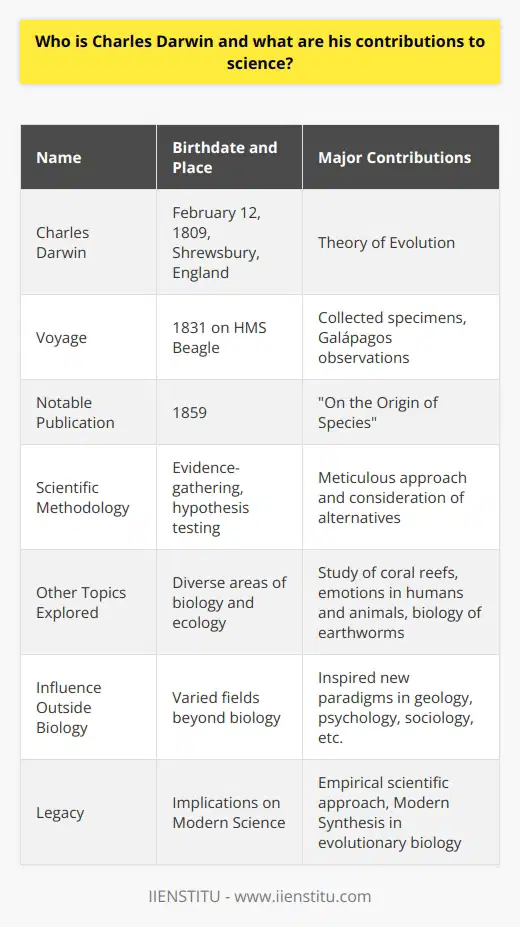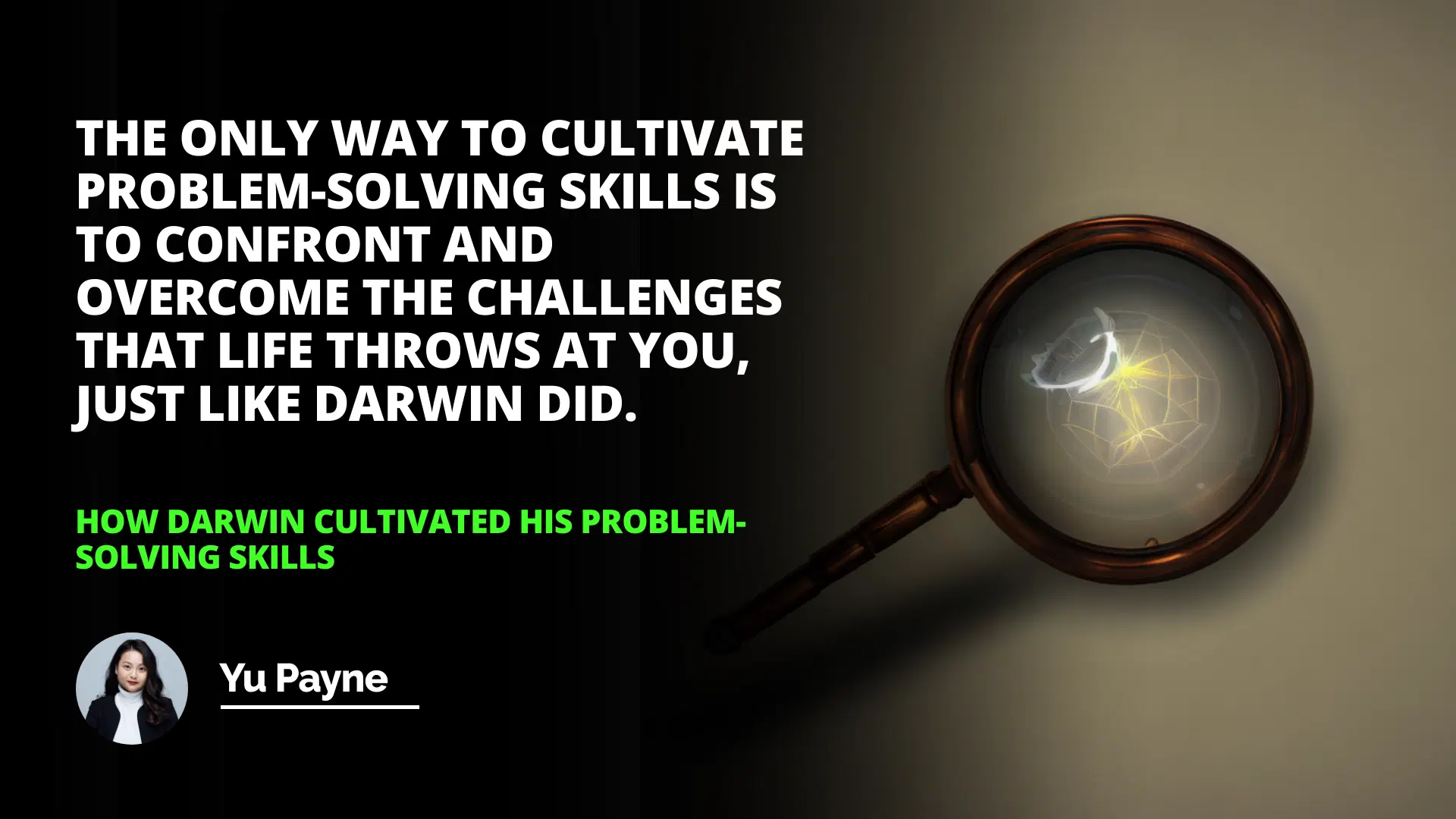
I remember the first time I stumbled upon Charles Darwin's work. It was a warm summer afternoon, and I was lazily flipping through my grandfather's dusty old books in the attic. Among the tattered pages, one title caught my eye: On the Origin of Species. Little did I know that this chance encounter would ignite a lifelong fascination with one of the most influential figures in modern science.
Introduction
Charles Darwin wasn't just a scientist; he was an explorer, a thinker, and someone who dared to question the world around him. His theories didn't just reshape biology—they revolutionized our understanding of life itself. Let's embark on a journey through Darwin's life, exploring his education and background, delving into the depths of his most memorable quotes, and uncovering the problem-solving skills that made his work so monumental.
Introduction
Darwin's Education and Background
Darwin's Quotes and Their Meaning
Darwin's Problem-Solving Skills
Conclusion
Darwin's Education and Background
Born on February 12, 1809, in the quaint town of Shrewsbury, Shropshire, Darwin came from a well-to-do family. His father, Dr. Robert Darwin, was a successful physician, and his mother, Susannah Wedgwood, was part of the famed Wedgwood pottery family. This comfortable upbringing afforded young Charles opportunities that many could only dream of.
As a boy, Darwin attended Shrewsbury School, a place that, from what I've read, seemed both imposing and inspiring. The strict regimen might have been stifling for some, but it was here that Darwin began to cultivate his keen interest in the natural world. He was the kind of student who preferred collecting beetles to memorizing Latin—something I can certainly relate to!
University Days
At sixteen, Darwin was sent to the University of Edinburgh to study medicine. However, the sight of blood made him queasy, and he found the lectures dreadfully dull. Seeking refuge, he immersed himself in natural history, spending hours exploring the shoreline and studying marine life.
Realizing that medicine wasn't his calling, Darwin's father sent him to Christ's College, Cambridge, to study theology. Ironically, it was here that Darwin's scientific passions truly blossomed. Under the mentorship of botanist John Stevens Henslow, Darwin became engrossed in geology and biology. Henslow once described him as a man who was "certainly the most engaging companion I met with during my travels."
The Voyage That Changed Everything
In 1831, at just 22 years old, Darwin received an invitation that would alter the course of his life—and science—as we know it. He was to join the HMS Beagle as a naturalist on a survey expedition around the globe. I imagine the decision wasn't easy; leaving home for a five-year journey into the unknown would be daunting for anyone. Yet, with his family's reluctant blessing, Darwin set sail.
The voyage of the Beagle was nothing short of epic. From the lush rainforests of South America to the unique ecosystems of the Galápagos Islands, Darwin had a front-row seat to nature's grandeur. He meticulously collected specimens, kept detailed journals, and began to notice patterns that would later form the backbone of his theory of natural selection.
Darwin's Quotes and Their Meaning
Darwin was not only a keen observer but also a profound thinker. Some of his quotes have resonated with me over the years, offering wisdom that extends beyond science.
The only way to cultivate problem-solving skills is to confront and overcome life's challenges, just like Darwin did.
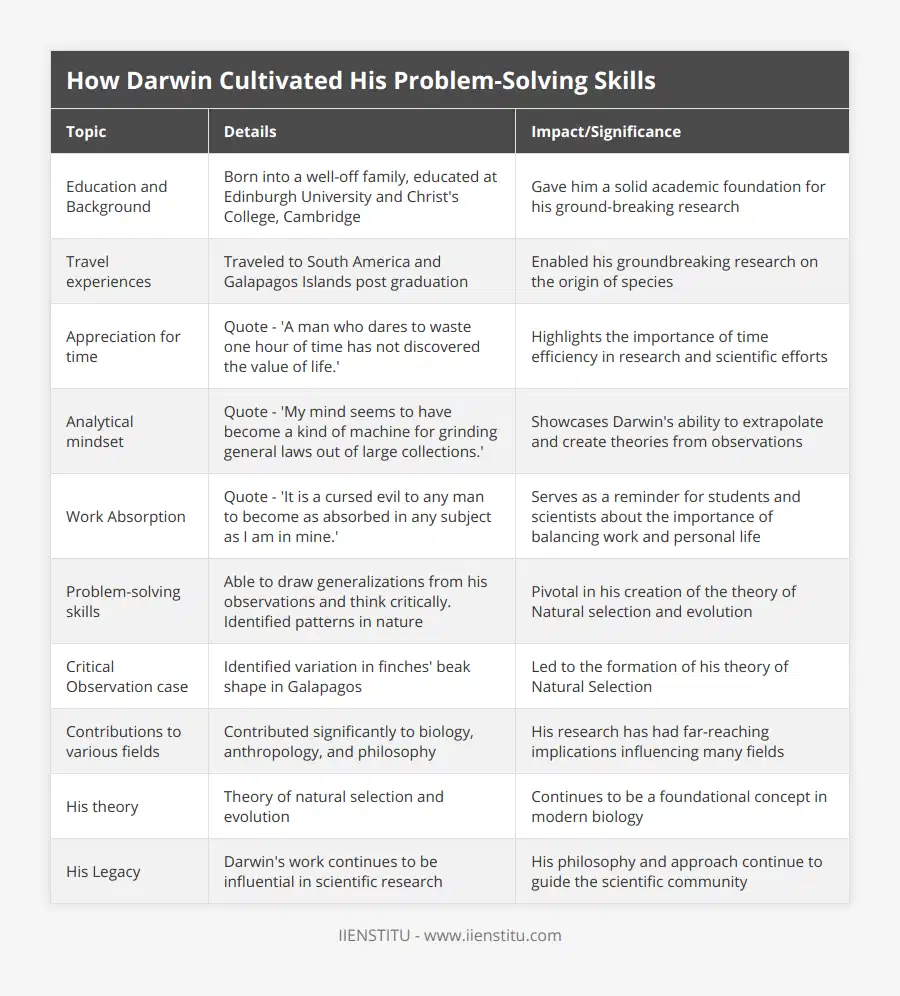
"A man who dares to waste one hour of time has not discovered the value of life."
This quote speaks volumes about Darwin's appreciation for time and productivity. In today's hustle culture, it's a reminder to make the most of every moment—a notion that sometimes gets lost in our fast-paced lives.
Another favorite is:
"My mind seems to have become a kind of machine for grinding general laws out of large collections of facts."
Here, Darwin humbly acknowledges his ability to synthesize vast amounts of data into overarching principles. It's a testament to his analytical prowess and speaks to the importance of critical thinking—a skill that's as valuable today as it was in the 19th century.
He also quipped:
"It is a cursed evil to any man to become as absorbed in any subject as I am in mine."
I chuckle every time I read this. It's a candid admission of his obsession with his work, something many of us can relate to when we're passionate about a project or hobby. But it also serves as a cautionary note about maintaining balance—a lesson I've had to learn the hard way more than once!
Darwin's Problem-Solving Skills
Darwin's ability to identify patterns and draw conclusions was nothing short of remarkable. During his time on the Galápagos Islands, he observed finches with varying beak shapes and sizes. Instead of dismissing these differences as mere curiosities, he pondered their significance.
Connecting the Dots
He began to theorize that these variations were adaptations to different food sources—a radical idea at the time. This led to the formation of his theory of natural selection, proposing that species evolve over generations through a process of heritable traits that enhance survival and reproduction.
In many ways, Darwin's approach mirrors the critical path method project management strategy. Just as project managers identify essential tasks that directly impact the project's success, Darwin focused on critical variations that influenced a species' ability to survive. By honing in on these key factors, he was able to develop a comprehensive theory that has stood the test of time.
Personal Anecdote: Applying Darwin's Methods
I recall working on a complex project at my previous job. We were tasked with reducing the company's carbon footprint—a lofty goal with many moving parts. Feeling overwhelmed, I took a step back and thought about how Darwin approached his work. By breaking down the project into critical components and analyzing the data meticulously, we were able to devise a strategy that not only met but exceeded our targets. It was a real-world application of Darwin's problem-solving ethos.
Underlined Lessons from Darwin's Approach
Meticulous Observation: Darwin didn't rush to conclusions. He took time to observe and document, ensuring his findings were well-supported.
Openness to New Ideas: He was willing to challenge established beliefs, a trait that's vital for innovation.
Interdisciplinary Thinking: Darwin drew from geology, biology, and even psychology, illustrating the importance of a holistic approach.
Incorporating Long-Tail Keywords
Darwin's journey on the HMS Beagle wasn't just a voyage around the world; it was the foundation for Charles Darwin's theory of natural selection. His observations in diverse ecosystems contributed significantly to Darwin's contribution to modern science. The impact of Darwin's voyage on the Beagle extends beyond biology, influencing fields like ecology and environmental science.
Moreover, the influence of Darwin's work on philosophy cannot be overstated. Philosophers and ethicists have grappled with the implications of his theories for over a century. Darwin's problem-solving approach in research exemplifies how meticulous analysis and openness to new ideas can lead to groundbreaking conclusions.
Unique Examples of Darwin's Influence
Darwin's theories didn't just remain within scientific circles; they permeated culture, society, and even technology.
Medicine: Understanding evolution has been crucial in developing vaccines and antibiotics.
Technology: Concepts like genetic algorithms in computer science are inspired by natural selection.
Psychology: Evolutionary psychology explores how evolutionary principles influence human behavior.
Numbered List: How Darwin's Work Affects Us Today
1- Education: School curriculums worldwide teach evolutionary biology, shaping how future generations understand life.
2- Conservation Efforts: Insights into species adaptation inform conservation strategies, helping protect endangered species.
3- Medical Advancements: Evolutionary principles guide research in genetics and disease control.
4- Ethical Debates: His work sparks discussions on topics like cloning and genetic modification.
5- Cultural Impact: Art, literature, and philosophy have all drawn inspiration from Darwinian concepts.
Conclusion
Reflecting on Charles Darwin's life, I'm struck by his unwavering curiosity and dedication. He wasn't afraid to venture into the unknown, both literally and intellectually. His journey teaches us that embracing challenges and asking the hard questions can lead to extraordinary discoveries.
In our own lives, whether we're scientists, artists, or simply souls navigating this complex world, there's much to learn from Darwin. His story reminds us to observe deeply, think critically, and perhaps most importantly, to never stop exploring.
The only way to cultivate problem-solving skills is to confront and overcome life's challenges, just like Darwin did. After all, it's through these trials that we grow, learn, and maybe even change the world.
References
1- Darwin, C. (1859). On the Origin of Species by Means of Natural Selection. London: John Murray.
2- Browne, J. (1995). Charles Darwin: Voyaging. Princeton: Princeton University Press.
3- Desmond, A., & Moore, J. (1991). Darwin. London: Michael Joseph.
4- Ghiselin, M. T. (1969). The Triumph of the Darwinian Method. Berkeley: University of California Press.
5- Himmelfarb, G. (1959). Darwin and the Darwinian Revolution. New York: Doubleday Anchor Books.
Frequently Asked Questions
What educational background did Darwin have that enabled him to develop his problem-solving skills?
Charles Darwin is widely recognized as one of the most influential scientists. His groundbreaking theories on evolution revolutionized the way we understand the natural world. But what educational background enabled Darwin to develop the problem-solving skills necessary to arrive at such a groundbreaking conclusion?
Darwin was born into a wealthy English family and received a privileged education. He attended the Anglican Shrewsbury School, where he excelled academically. He was particularly passionate about natural history and was encouraged by his father to pursue this interest. After graduating from Shrewsbury, Darwin enrolled at the University of Edinburgh to study medicine. Although he found the material challenging and eventually withdrew, he gained invaluable knowledge of the scientific method during his time there.
In addition to his formal education, Darwin was exposed to a wide range of scientific literature during his teenage years. In particular, he read works by the French naturalist Jean-Baptiste Lamarck, which provided an early hypothesis on evolution. He also read treatises written by the British botanist Joseph Hooker, further developing his interest in natural history.
His extensive travels also shaped Darwin's problem-solving skills. For example, during his famous voyage on the HMS Beagle, Darwin made detailed observations of the various plants and animals he encountered. His meticulous notes, which were used to formulate his theories on evolution, demonstrate the importance of Darwin's intellectual curiosity and keen observational skills.
Overall, Darwin's educational background provided the foundation for his problem-solving skills. His privileged education and exposure to scientific literature equipped him with a solid knowledge of the scientific method. His travels aboard the HMS Beagle also provided a wealth of observational evidence that enabled him to develop his theories. Ultimately, Darwin's combination of formal education, scientific readings, and observational experience helped him to develop the problem-solving skills necessary to revolutionize the field of natural history.
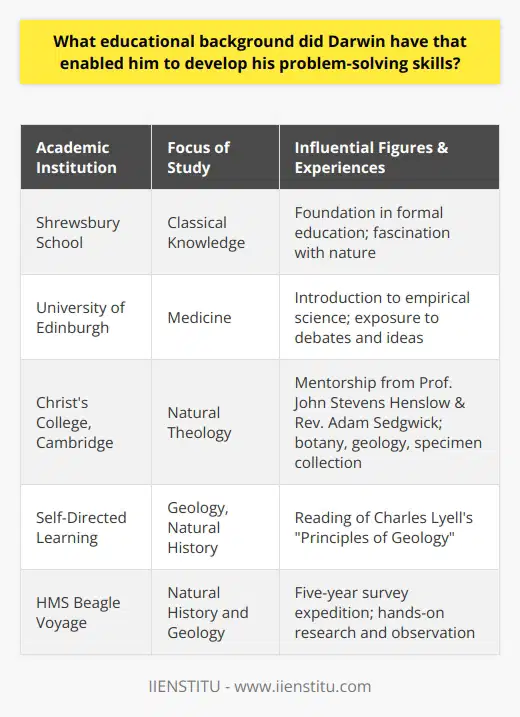
How did Darwin's quotes reflect his problem-solving skills?
Charles Darwin is widely regarded as one of the greatest minds of the 19th century and was renowned for his problem-solving skills. His observations and theories revolutionized the field of evolutionary biology, and his quotes offer insight into his approach to problem-solving.
Darwin’s most famous quote is, “It is not the strongest of the species that survives, nor the most intelligent, but the one most responsive to change.” This phrase reflects Darwin’s understanding of how the process of natural selection works and his ability to adapt to changing conditions. Furthermore, it shows his ability to recognize the importance of being flexible and open to different possibilities when confronting a problem.
Another famous quote by Darwin is, “A man who dares to waste one hour has not discovered the value of life.” This quote shows his appreciation for the importance of efficient problem-solving. Darwin knew that time is a precious resource and that it is essential to be purposeful and efficient to make the most of it. He believed that wasting time was a waste of life, and this quote reflects his determination to make the most of his time.
Another quote by Darwin that reflects his problem-solving skills is, “Ignorance more frequently begets confidence than does knowledge.” This quote emphasizes the importance of being aware of one’s limitations. Darwin understood that one must be mindful of their knowledge to make the best decisions, and this quote reflects his insight into the importance of being humble and open to new ideas.
These quotes by Charles Darwin offer insight into his approach to problem-solving. They reflect his understanding of the importance of being flexible, efficient, and humble when facing a problem. His quotes demonstrate the brilliance of his mind and the insight that he had into the process of problem-solving.
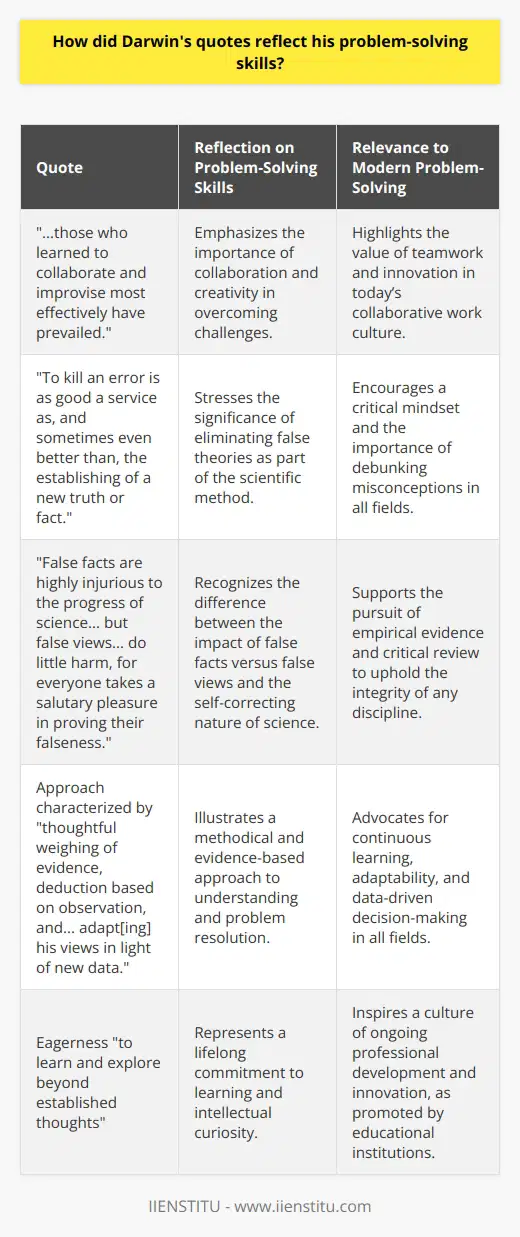
What strategies did Darwin use to cultivate his problem-solving skills?
Charles Darwin is widely considered one of the greatest scientific minds of all time, and his contributions to the field of evolutionary biology are unparalleled. As such, it is no surprise that Darwin was an incredibly talented problem-solver, able to think outside the box and develop innovative solutions to complex problems. But how did he cultivate this skill? In this article, we will explore Darwin's strategies to develop his problem-solving skills.
One of the essential strategies Darwin employed was a willingness to experiment. He was not afraid to try out new approaches to problems and often conducted experiments to test the validity of his hypotheses. For example, Darwin famously conducted his famous voyage on the HMS Beagle to observe and collect data about the natural world to understand the process of evolution better. His willingness to test his theories was vital in helping him develop his problem-solving skills.
Another critical strategy Darwin employed was the process of elimination. He would often start with the assumption that a particular problem had many possible solutions and then systematically eliminate those solutions that were not viable. This allowed him to focus on the most promising solutions and eventually arrive at the correct answer.
Finally, Darwin was a master of observation. He could look at a problem from multiple angles, allowing him to see the bigger picture. He could also look at the situation objectively and consider various solutions rather than quickly jumping to one conclusion. This allowed him to devise creative solutions that others may not have considered.
By employing these strategies, Darwin cultivated his problem-solving skills and became one of the most influential scientists of all time. His willingness to experiment, the process of elimination, and mastery of observation all helped him develop this skill and ultimately revolutionize the field of evolutionary biology.
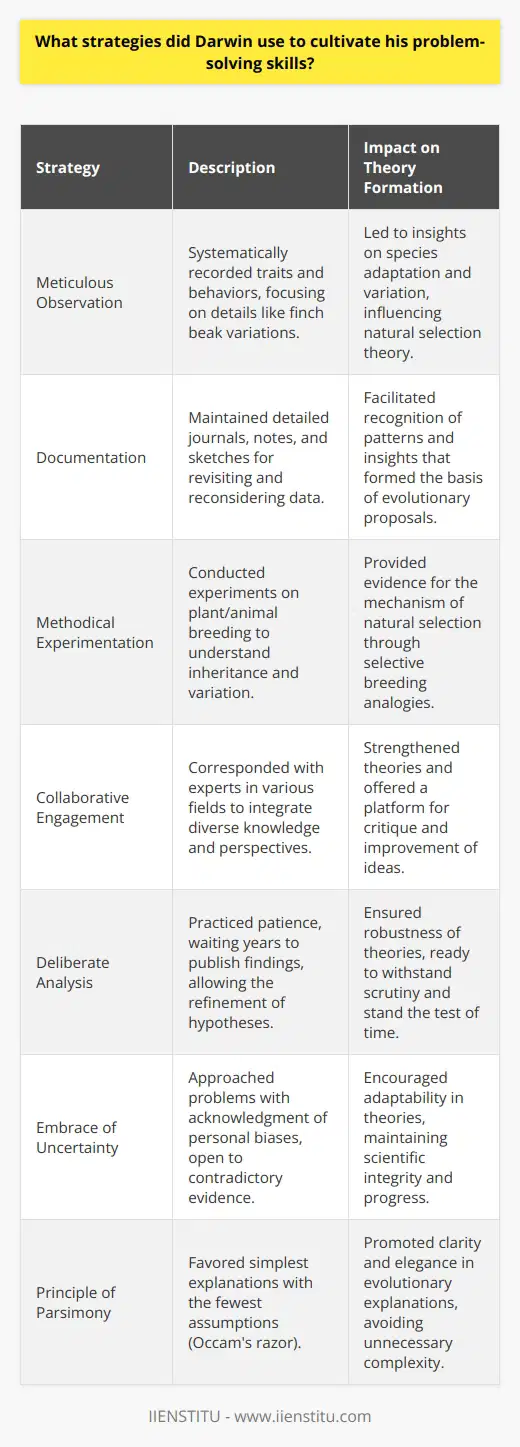
Which of the following were lines of evidence used by Darwin to develop his theory of natural selection?
**Evidence from Fossils**
One crucial line of evidence Darwin used to develop his theory of natural selection was the study of fossils. These preserved remains of ancient organisms allowed him to observe and compare extinct species with living ones, noting the gradual changes that occurred over time. By understanding the patterns of the past, he deduced that species had evolved through a process of adaptation to their environment.
**Anatomical Similarities**
Another essential component of Darwin's theory was noting anatomical similarities among different species. He observed homologous structures, anatomical features that serve different functions but originate from a shared evolutionary ancestor. This evidence suggested that various species evolved from a common ancestor, supporting the idea that natural selection played a critical role in shaping the diversity of organisms.
**Embryology**
Darwin also recognized the importance of embryology as a source of evidence for natural selection. He observed that embryos of different species bear striking resemblances to each other during early stages of development. These similarities implied a shared evolutionary origin and reinforced the idea that species evolved over time through the process of natural selection.
**Geographical Distribution**
The geographical distribution of organisms was another line of evidence Darwin used to shape his theory. He observed that organisms inhabiting similar environments but located in different parts of the world often had comparable adaptations. This observation led him to believe that different species faced similar environmental pressures and evolved convergently to survive and reproduce.
**Artificial Selection**
Lastly, Darwin's understanding of artificial selection, the human-driven process of breeding organisms with desired traits, provided important insights into the process of natural selection. He reasoned that if humans could influence the heritable traits of organisms through selective breeding, then nature could similarly exert selective pressure on organisms to shape the characteristics of species over time.
In conclusion, the lines of evidence used by Darwin to develop his theory of natural selection included fossils, anatomical similarities between species, embryology, geographical distribution of organisms, and artificial selection. Together, these pieces of evidence allowed Darwin to establish the foundational principles of evolution, which continue to shape our understanding of life on Earth to this day.
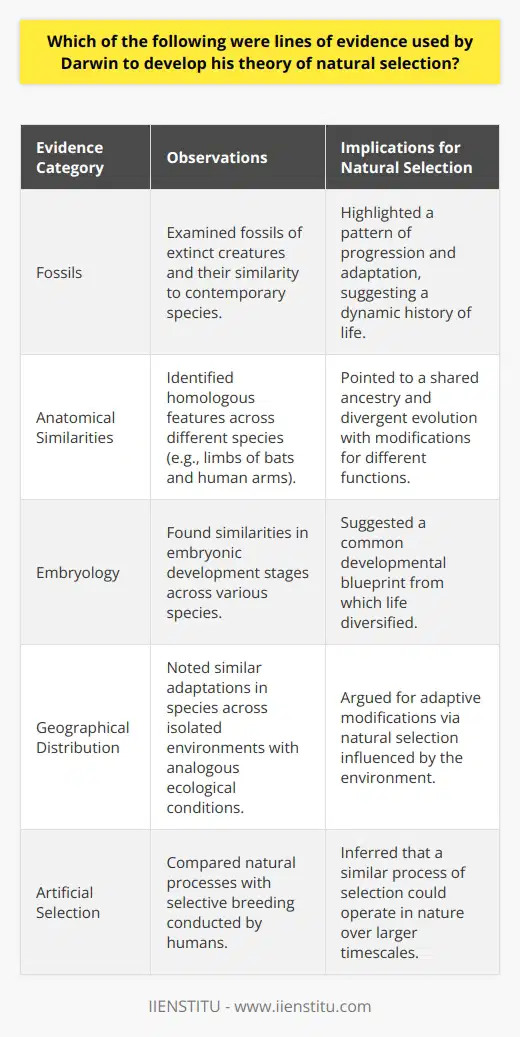
What were the discoveries of Charles Darwin?
Discoveries of Charles Darwin:
Early Career Contributions
Charles Darwin, a renowned naturalist and biologist, made several groundbreaking discoveries throughout his career. One of his earliest contributions was in the field of geology. Darwin began developing his theory of coral reef formation while on the HMS Beagle's voyage. He proposed that coral reefs grow on sinking volcanic islands, presenting an innovative perspective.
Evolutionary Theory Development
The cornerstone of Darwin's discoveries is the development of the theory of evolution by natural selection. This theory posits that species evolve over time through the gradual accumulation of advantageous adaptations, driven by the forces of natural selection. Darwin meticulously gathered evidence to support this idea through the analysis of fossils, animal breeding, and comparisons of species across various environments.
Concept of Common Descent
Darwin's evolutionary theory led him to propose the idea of common descent, where he argued that all life on Earth shares a common ancestor. This concept implies that over time, species have diverged and diversified from their ancestral origins. This groundbreaking idea provided a foundation for modern evolutionary biology and transformed how scientists view the relationships between species.
Sexual Selection Theory
In addition to natural selection, Darwin identified sexual selection as a driving force behind evolutionary change. He theorized that individuals with traits that are more appealing to potential mates have a competitive edge in reproduction, leading to the proliferation of these traits in future generations. This concept allowed for a more comprehensive understanding of the processes driving species differentiation and adaptation.
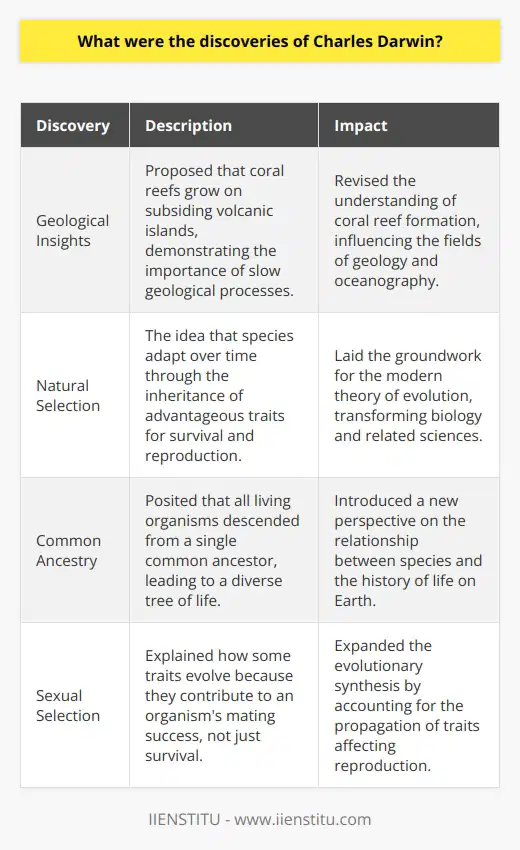
What are some of the organisms Darwin found observed and studied?
Organisms from the Galapagos Islands
One of the most influential organisms that Darwin studied were the finches from the Galapagos Islands. These small birds displayed significant variations in beak size and shape based on their diet and environment, which contributed to the development of his theory of natural selection.
Tortoises Displaying Variation
Another notable organism that Darwin observed were the Galapagos tortoises. He discovered that these giant reptiles showed distinctive differences in shell shape, depending on the island they inhabited, which led him to question the ideas of species fixity and stability.
Marine Iguanas
Marine iguanas provided further evidence for Darwin's evolving ideas about adaptation and evolution. Remarkably, these creatures had developed a unique ability to swim and dive in the ocean for algae, showing a clear example of specialization based on environmental pressures.
Barnacles and Insect Diversity
Besides studying larger animals, Darwin also spent a significant amount of time observing minute creatures, such as barnacles and insects. It was his meticulous analysis of barnacle morphology and the striking diversity of insect forms that helped reinforce his understanding of the vast range of potential adaptations within species.
Fossils as Evidence for Evolution
Finally, Darwin's study of fossils played a crucial role in the formation of his views on evolution. Specifically, he observed the extinct glyptodont and remarked on its striking similarities to modern armadillos. This observation led him to understand the concept of shared ancestry between living organisms and their extinct counterparts.
In conclusion, it was through observing and studying a diverse range of organisms - from finches and tortoises to marine iguanas, barnacles, insects and fossils - that Darwin began to develop his groundbreaking theory of evolution by means of natural selection. His comprehensive examination of these various species solidified his understanding of the powerful role of adaptation in shaping the natural world.

What was Darwin's biggest question he was trying to answer?
Darwin's Central Inquiry
Charles Darwin, the renowned evolutionary biologist, dedicated his life to the pursuit of knowledge regarding the origins and progression of species on Earth. Though he explored various aspects of natural history, his central question revolved around unraveling the mechanisms underlying the great diversity of life. Specifically, how does a single species diversify into myriad forms with different characteristics?
Theory of Natural Selection
In attempting to answer this question, Darwin embarked on a scientific journey to understand the fundamental principles that governed species diversity. His revolutionary book, 'On the Origin of Species,' presented the groundbreaking theory of natural selection, which provided a comprehensive explanation for the diversification of life on Earth.
Role of Competition and Adaptation
Darwin's hypothesis of natural selection posited that species evolve as a result of a process in which the fittest individuals survive and reproduce, while the less fit die out. This is crucial as it suggests that species encounter competition for limited resources, and those that adapt best to their environment thrive, passing on advantageous traits to their offspring. Consequently, these traits become more common within the population over successive generations.
Fitness and Survival
Examining Darwin's central question further, it is critical to note that he was trying to decipher why certain traits are passed on while others are not. He recognized that some inherited characteristics contribute to an organism's 'fitness' or ability to survive and reproduce. Therefore, the biggest question Darwin sought to answer can be framed as unraveling the underlying reasons behind the differential survival and transmission of traits within and across species.
Relevance of Darwin's Question Today
Ultimately, Darwin's quest to understand species diversification has had a profound impact on modern biology and our comprehension of the natural world. Insights gleaned from his seminal works have elucidated the essential importance of competition and adaptation in shaping the dynamics of life on Earth. Scientists continue to explore and expand upon Darwin's theories, striving to unlock further mysteries regarding the processes governing evolution and biodiversity. As such, the question at the heart of Darwin's work retains its relevance and significance in contemporary research.
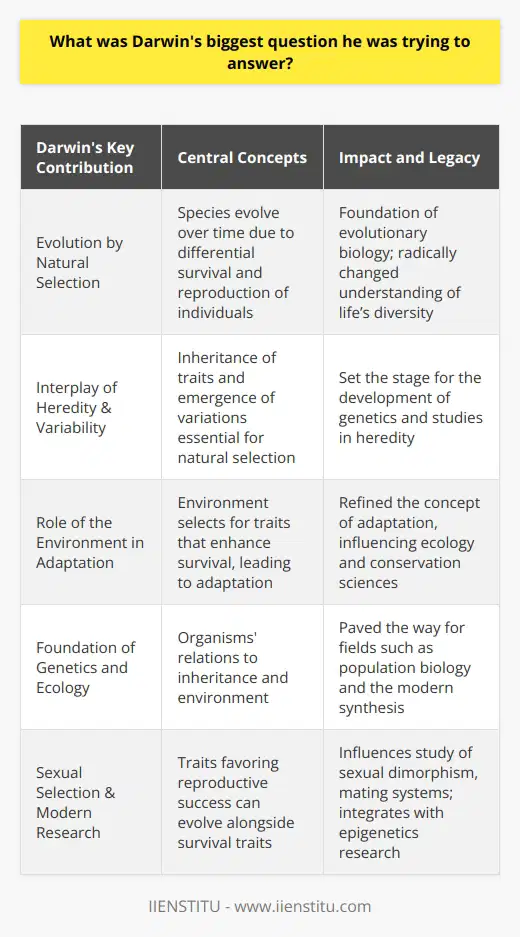
What are 3 things Charles Darwin is known for?
Evolutionary Theory
First, Charles Darwin is known for his groundbreaking work on evolution, primarily through his book 'On the Origin of Species'. Published in 1859, this work presented the concept that species undergo natural selection, resulting in adaptations to their environment, and ultimately leading to the diversification of life on Earth. Darwin's ideas laid the foundation for the study of evolutionary biology, profoundly altering our understanding of life and threating long-held religious beliefs about creation.
Voyage of the HMS Beagle
Secondly, Darwin's fame as a scientist is primarily rooted in the five-year voyage he undertook on the HMS Beagle from 1831-1836. During this journey, he was tasked to investigate the geology and natural history of various regions around the world, such as South America and the Galápagos Islands. These explorations facilitated the development of his ideas concerning evolution and natural selection, as he was inspired by the diversity of life and the varied adaptations of species to their environments. The Beagle voyage was a pivotal moment in Darwin's life, ultimately guiding his life's work and research.
Contribution to Geology
Lastly, in addition to his influence on biology, Darwin made significant contributions to the field of geology. Throughout the voyage of the HMS Beagle, he meticulously recorded observations on geological formations he discovered, such as the structure and distribution of coral reefs, volcanic island formation, and effects of erosion. These observations assisted in developing a deeper understanding of Earth's history and its dynamic physical processes. In fact, Darwin believed his geological work to be as significant as his biological contributions; for instance, his book on coral reefs helped to establish his reputation as a geologist.
In summary, Charles Darwin is renowned for his revolutionary ideas in evolutionary biology, his formative experiences during the voyage of the HMS Beagle, and his influential contributions to geology. With these achievements, Darwin not only changed our understanding of life on Earth, but also left a lasting impact on various scientific disciplines for generations to come.

Who is Charles Darwin and what are his contributions to science?
Charles Darwin: An Influential Scientist
Charles Darwin was a British naturalist born in 1809, who gained immense prominence for his groundbreaking contributions to science. Although primarily known for his revolutionary theories on natural selection, Darwin's work encompassed various areas of scientific inquiry.
Theory of Evolution and Natural Selection
The primary scientific contribution by Darwin is the theory of evolution through natural selection. He outlined this theory in his seminal work, 'On the Origin of Species,' published in 1859. This book provided the scientific community with abundant evidence that species evolve over time, primarily driven by environmental factors. Through the process of natural selection, organisms with advantageous traits in a particular environment tend to survive and reproduce at higher rates.
Darwin's Foresight and the Concept of Gradualism
A key component of Darwin's evolutionary theory is the concept of gradualism – the idea that slow, gradual changes accumulate over time, resulting in significant, observable differences among species. He excelled in observing and predicting the variations and changes in species due to environmental pressures. This concept stands in stark contrast to the prevailing belief in the mid-19th century that the Earth's species were static and unchanging.
Impact on Genetics and the Modern Synthesis
Although Darwin did not know the exact mechanism underlying heredity and trait inheritance, his research laid the foundation for subsequent investigations in genetics. His theories were later connected with the work of Gregor Mendel, the father of modern genetics, leading to the development of the Modern Synthesis. This comprehensive theory integrated Darwinian natural selection with Mendelian inheritance, better explaining the observed patterns of species transformations.
Influence on Scientific Disciplines Beyond Biology
Darwin's work has had a lasting impact not only in the field of biology but also in various other scientific disciplines. His theories and methods have informed and inspired research in fields such as geology, ecology, psychology, and anthropology. Consequently, his work has become an indispensable part of the framework for understanding biological processes, enabling modern scientists to develop new hypotheses and explanations.
In conclusion, Charles Darwin's prodigious contributions to science have left an indelible mark on our understanding of the natural world. His theory of evolution by natural selection has allowed us to recognize the interconnectedness and fluidity of species, paving the way for a more comprehensive comprehension of biological processes, the foundation of life sciences.
